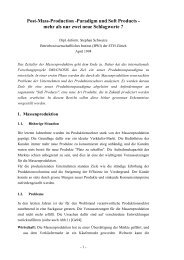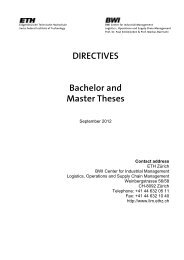The China Venture
The China Venture
The China Venture
Create successful ePaper yourself
Turn your PDF publications into a flip-book with our unique Google optimized e-Paper software.
them, while a branch with a shortage of funds could in no way get in contact with another<br />
branch. 51<br />
<strong>The</strong> reforms in 1979 put limits on the credit banks could extend and made their lending<br />
capacity conditional on their deposit-raising abilities. In 1983, an unofficial interbank market<br />
was created on an experimental basis by a regional branch of the ABC. This horizontal<br />
interface between branches marked a change from the previous, vertical system. <strong>The</strong><br />
experiment proved such a success that branches of other banks were included in the system.<br />
As a result of early moves to liberalise the financial sector, sporadic interbank trading<br />
between branches of specialised banks emerged in 1985. <strong>The</strong> reason was the increasing need<br />
for local interbank markets which came from the shortage of credit through a restrictive<br />
monetary policy implemented by the PBOC in 1985. In November 1995, the PBOC<br />
announced its intentions to link the banks and the most important regional money markets<br />
electronically. But still, the interest rates are tightly controlled, which makes the money<br />
market not very effective. By the end of 1987, interbank markets existed in nearly all regions.<br />
But the lack of proper regulatory framework and of supervision by monetary authorities<br />
allowed the creation of „finance companies“ and development of unauthorised activities, such<br />
as short-term borrowing and long-term lending. As the PBOC declared that no authorities<br />
would intervene in any way, interbank activities of various kind sprang up in most large cities<br />
across the country.<br />
In 1989, these finance companies were abolished by the PBOC and in 1990, standardised<br />
operating principles of interbank markets came into effect. <strong>The</strong> interbank activities were<br />
centralised in some well-defined market places in Shanghai, Wuhan, Beijing/Tianjin,<br />
Shenyang, Xi’an and Chongqing. In Shanghai, the market took a more structured form in<br />
August 1986 with the establishment of the „Shanghai Money Market“, organised by the<br />
ICBC. <strong>The</strong> ICBC often accounts for more than three quarters of all interbank activities in<br />
<strong>China</strong>, although in principle, any financial institution may operate on this market after<br />
approval by the PBOC. Still, the interbank market is quite segmented while the extent of<br />
segmentation depends on the stature of the region or centre concerned. It is organised in three<br />
layers: markets, centres and networks. <strong>The</strong> market itself is organised locally by financial<br />
institutions and sponsored by local branches of the PBOC. Links between these three layers<br />
are poor due to the underdeveloped telecommunications, the inadequacy of organisation by<br />
51 See Dipchand et. Al, 1994; Girardin, 1997 and Xia, 1995.<br />
39






